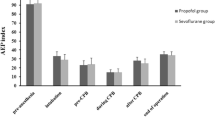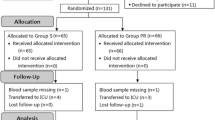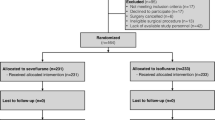Summary
Background
Clinical studies have shown that sevoflurane is cardio-protective in cardiac surgery patients, but this effect is doubtful in general surgery patients. This study has researched the influence of sevoflurane on the perioperative cardiac function and the incidence of cardiac ischaemic events in abdominal surgical patients.
Methods
Out of 80 patients scheduled for elective colorectal surgery, 42 received balanced sevoflurane-fentanyl anaesthesia, while 38 received intravenous midazolam-fentanyl anaesthesia. The cardiac index (CI) and cardiac function index (CFI) were measured by the PiCCO device, and Troponin I levels were measured at the beginning of surgery, as well as 4, 12 and 24 h afterwards. BNP was measured at the beginning of surgery, and 24 h afterwards. The data analysis was conducted using the Mann–Whitney nonparametric test, with statistical significance set at p < 0.05.
Results
There was no statistical difference in perioperative Troponin I, BNP, CI and CFI values between the SEVO and TIVA groups throughout the perioperative period.
Conclusions
Sevoflurane had no effect on the cardiac biomarkers Troponin I and BNP, and on the PiCCO parameters of cardiac function in abdominal surgical patients. Further research on the preconditioning effect of volatile anaesthetics in general surgical population should be concentrated on the population of patients with a high perioperative cardiac risk.
Similar content being viewed by others
References
Pearse RM, Harrison DA, James P, Watson D, Hinds C, Rhodes A, Grounds RM, Bennett ED. Identification and characterisation of the high-risk surgical population in the United Kingdom. Crit Care. 2006;10:81–7.
Khuri SF, Henderson WG, DePalma RG, Mosca C, Healey NA, Kumbhani DJ, Participants in the VA National Surgical Quality Improvement Program. Determinants of long-term survival after major surgery and the adverse effect of postoperative complications. Ann Surg. 2005;242:326–43.
Tekkis PP, Poloniecki JD, Thompson MR, Jeffrey D. Operative mortality in colorectal cancer: prospective national study. BMJ. 2003;327:1196–201.
Grayburn PA, Hills D. Cardiac events in patients undergoing noncardiac surgery: shifting the paradigm from non-invasive risk stratification to therapy. Ann Int Med. 2003;6:506–12.
Windsor A, French GWG, Sear JW, Foex P, Millett SV, Howell SJ. Silent myocardial ischaemia in patients undergoing transurethral prostatectomy. Anaesthesia. 1996;51:728–32.
Zaugg M, Schaub MC, Foex P. Myocardial injury and its prevention in the perioperative setting. Br J Anaesth. 2004;93:21–33.
Tanaka K, Ludwig LM, Kersten JR, Pagel PS, Wartlier DC. Mechanisms of cardioprotection by volatile anesthetics. Anesthesiology. 2004;100:707–21.
Lynch C. Anesthetic preconditioning. Anesthesiology. 1999;91:606–8.
Zaugg M, Lucchinetti E, Uecker M, Pasch T, Schaub MC. Anaesthetics and cardiac preconditioning. Part I. Signalling and cytoprotective mechanisms. Br J Anaesth. 2003;91:551–65.
Bland JH, Lowenstein E. Halothane-induced decrease in experimental myocardial ischemia in the non-failing canine heart. Anesthesiology. 1976;45:287–93.
Mullenheim J, Ebel D, Bauer M, Otto F, Heinen A, Frassdorf J, Preckel B, Schlack W. Sevoflurane confers additional cardioprotection after ischemic late preconditioning in rabbits. Anesthesiology. 2003;99:624–31.
Serita R, Morisaki H, Ai K, Morita Y, Innami Y, Satoh T, Kosuqi S, Kotake Y, Takeda J. Sevoflurane preconditions stunned myocardium in septic but not healthy isolated rat hearts. Br J Anaesth. 2002;89:896–903.
Lucchinetti E, Aguirre J, Feng J, Zhu M, Suter M, Spahn DR, Härter L, Zaugg M. Molecular evidence of late preconditioning after sevoflurane inhalation in healthy volunteers. Anesth Analg. 2007;105:629–40.
De Heart SG, Cromheecke S, Broecke PW, Mertens E, De Blier IG, Stockman BA, Rodrigus IE, Van der Linden PJ. Effects of propofol, desflurane, and sevoflurane on recovery of myocardial function after coronary surgery in elderly high-risk patients. Anesthesiology. 2003;99:314–23.
Bein B, Renner J, Caliebe D, Scholz J, Paris A, Fraund S, Zaekle W, Tonner PH. Sevoflurane but not propofol preserves myocardial function during minimally invasive direct coronary artery bypass surgery. Anesth Analg. 2005;100:610–6.
De Hert SG, Van der Linden PJ, Cromheecke S, Meeus R, Nelis A, Van Reeth V. Cardioprotective properties of sevoflurane in patients undergoing coronary surgery with cardiopulmonary bypass are related to the modalities of its administration. Anesthesiology. 2004;101:299–310.
De Hert SG, Van der Linden PJ, Cromheecke S, Meeus R, ten Broecke PW, De Blier IG, Stockman BA, Rodrigus IE. Choice of primary anesthetic regimen can influence intensive care unit length of stay after coronary surgery with cardiopulmonary bypass. Anesthesiology. 2004;101:9–20.
Garcia C, Julier K, Bestmann L, Zollinger A, Segesser LK, Pasch T, Spahn DR, Zaugg M. Preconditioning with sevoflurane decreases PECAM-1 expression and improves one-year cardiovascular outcome in coronary artery bypass graft surgery. Br J Anaesth. 2005;94:159–65.
Lee TH, Marcantonio ER, Mangione CM, Thomas EJ, Polanczyk CA, Cook EF, Sugarbaker DJ, Donaldson MC, Poss R, Ho KKL, Ludwig LE, Pedan A, Goldman L. Derivation and prospective validation of a simple index for prediction of cardiac risk of major noncardiac surgery. Circulation. 1999;100:1043–9.
Symons JA, Myles PS. Myocardial protection with volatile anaesthetic agents during coronary artery bypass surgery: a meta-analysis. Br J Anaesth. 2006;97:127–36.
Yu CH, Beattie WS. The effects of volatile anesthetics on cardiac ischemic complications and mortality in CABG: a meta-analysis. Can J Anaesth. 2006;53:906–18.
Landoni G, Biondi-Zoccai GG, Zangrillo A, Bignami E, Avolio SD, Marchetti C, Calabro MG, Fochi O, Guarracino F, Tritapepe L, DeHert S, Torri G. Desflurane and sevoflurane in cardiac surgery: a meta-analysis of randomized clinical trials. J Cardiothorac Vasc Anesth. 2007;21:502–11.
Landoni G, Fochi O, Bignami E, Calabro MG, Arpa MCD, Moizo E, Mizzi A, Pappalardo F, Morelli A, Zangrillo A. Cardiac protection by volatile anesthetics in non-cardiac surgery? A meta-analysis of randomized controlled studies on clinically relevant endpoints. HSR Proc Intensive Care Cardiovasc Anesth. 2009;1:34–43.
Zangrillo A, Testa V, Aldrovandi V, Tuoro A, Casiraghi G, Cavenago F, Messina M, Bignami E, Landoni G. Volatile agents for cardiac protection in noncardiac surgery: a randomized controlled study. J Cardiothorac Vasc Anesth. 2011;25:902–7.
De Hert SG, Longrois D, Yang H, Fleisher LA. Does the use of a volatile anesthetic regimen attenuate the incidence of cardiac events after vascular surgery? Acta Anaesth Belg. 2008;59:19–25.
Devereaux PJ, Goldman L, Cook DJ, Gilbert K, Leslie K, Guyatt GH. Perioperative cardiac events in patients undergoing noncardiac surgery: a review of the magnitude of the problem, the pathophysiology of the events and methods to estimate and communicate risk. CMAJ. 2005;173:627–34.
Martinez EA, Nass CM, Jermyn RM, Rosenbaum SH, Akhtar S, Chan DW, Malkus H, Weiss JL, Fleisher LA. Intermittent cardiac troponin-I screening is an effective means of surveillance for a perioperative myocardial infarction. J Cardiothorac Vasc Anesth. 2005;19:577–82.
Devereaux PJ, Chan MTV, Alonso-Coello P, Walsh M, Berwanger O, Villar JC, VISION Study Investigators, et al. Association between postoperative troponin levels and 30-day mortality among patients undergoing noncardiac surgery. JAMA. 2012;307:2295–304.
Dernellis J, Panaretou M. Assessment of cardiac risk before non-cardiac surgery: brain natriuretic peptide in 1590 patients. Heart. 2006;92:1645–50.
Julier K, Silva R D, Garcia C, Bestmann L, Frascarolo P, Zollinger A, Chassot PG, Schmid ER, Turina MI, von Segesser LK, Pasch T, Spahn DR, Zaugg M. Preconditioning by sevoflurane decreases biochemical markers for myocardial and renal dysfunction in coronary artery bypass graft surgery: a double-blinded, placebo-controlled, multicenter study. Anesthesiology. 2003;98:1315–27.
Lurati Buse GA, Schumacher P, Seeberger E, Studer W, Schuman RM, Fassl J, Kasper J, Filipovic M, Bolliger D, Seeberger MD. Randomized comparison of sevoflurane versus propofol to reduce perioperative myocardial ischemia in patients undergoing noncardiac surgery. Circulation. 2102;126:2696–704.
Fleisher LA, Beckman JA, Brown KA, Calkins H, Chaikof EL, Fleischmann KE, Freeman WK, Froehlich JB, Kasper EK, Kersten JR, Riegel B, Robb JF. ACC/AHA 2007 Guidelines on Perioperative Cardiovascular Evaluation and Care for Noncardiac Surgery: Executive Summary. A Report of the American College of Cardiology/American Heart Association Task Force on Practice Guidelines (Writing Committee to Revise 2002 Guidelines on Perioperative Cardiovascular Evaluation for Noncardiac Surgery). J Am Coll Cardiol. 2007;50:1707–32.
Author information
Authors and Affiliations
Corresponding author
Rights and permissions
About this article
Cite this article
Kopić, J. Volatile anaesthetics and cardiac protection in abdominal surgery. Wien Klin Wochenschr 127, 543–548 (2015). https://doi.org/10.1007/s00508-015-0819-2
Received:
Accepted:
Published:
Issue Date:
DOI: https://doi.org/10.1007/s00508-015-0819-2




